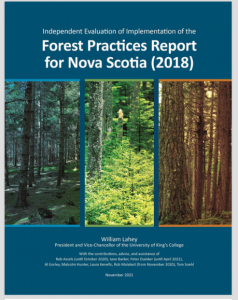Some time after 2019, the Early Mature and Late Mature categories were collapsed into one category (Mature); it’s not clear whether mature forest so labelled can be considered ‘Old Forest’ (forest 80 years and older). Given the clear evidence we have now that Old Forests (80 years & older) are critical for conservation of biodiversity, it would be welcomed if NRR maps personnel were to clearly define a category of Old Forest (forest known, or inferred based on multiple indices, to be 80 years of age and older), and include that as a new layer on both the Harvest Plan Map Viewer and the Provincial Landscape Viewer.

Distribution of forest in 5 development stages across Nova Scotia, compiled from NS Landscape Map Viewer in 2018. Purple = Multi-aged/Old Forest. Dark Green=Late Mature Forest. Click on image for larger version. View larger versions of the map: 2000 px | 4000 px.
Some time after 2019, the Early Mature and Late Mature categories were collapsed into one category (Mature).
This will be of interest to people who have been making use of the Forest Development Class layer on the the NS Provincial Landscape Viewer to get a sense of how much clearcutting there has been on landscape around new Crown harvest polygons shown on the Harvest Plan Map Viewer and/or how much Old Forest is left on a landscape (See HPMV – Forest Development Class).
I had been concentrating on the dark purple areas (Multi-aged/Old Forest) as the best indicators of Old Forest, but began to consider the dark green areas (late Mature Forest) as also indicative of Old Forest after a colleague suggested those are, generally, old Forest. I knew one example where that was certainly correct: “The Peninsula” on Sandy Lake, Bedford, which is dark green in the Forest Development Class Layer and the hemlock forest averaged 184 years (in 2014). That forest has a singe dominant older size class, and weak second size class, so I figured, Ok it wouldn’t be seen as multi-aged in aerial photographs, but otherwise has characteristics of Old Forest. So OK, the dark green is also ‘Old Forest’ Continue reading









